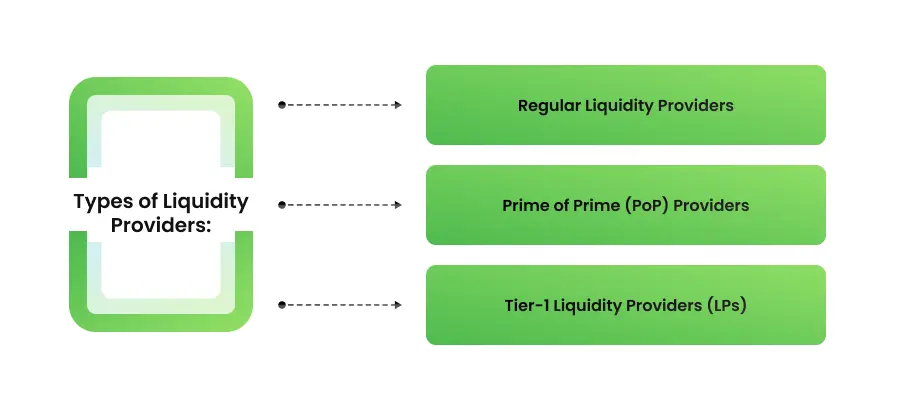From Multiple LPs To Single Pops: How To Choose A Perfect Liquidity Partner
- Introduction
- Understanding Liquidity in Financial Markets
- Types of Liquidity Providers
- Pros and Cons of Different Liquidity Partners
- Why PoPs Are Optimal For Mid-sized Brokerages
- Factors To Consider When Choosing A Liquidity Partner
- Final Recommendation
- Frequently Asked Questions (FAQs)
Introduction
Liquidity, often referred to as the “lifeblood of the financial market” is the most essential factor fueling activities in the financial market. In the financial markets, brokerage businesses’ survival is based on the availability and accessibility to robust liquidity pools and liquidity partners. A deep liquidity pool empowers brokerage businesses to offer competitive prices, efficiently execute clients’ orders, and minimize slippage.
Understanding Liquidity in Financial Markets
Liquidity is the ease with which assets can be bought or sold quickly, and at a fair price, without causing a significant change in its price. In brokerage services, access to rich liquidity pools helps with faster order execution, tighter spreads, and more reliable trading experience for users. Low liquidity, however, can result in order delays, wider spreads, and difficulty in fulfilling clients’ requests.
Types of Liquidity Providers
There are various sources of liquidity for brokerage businesses, each provider with its unique characteristics. They are:
- Tier-1 Liquidity Providers (LPs): These liquidity providers are well-established and large financial institutions with networks with major exchanges and numerous resources. They are usually characterized by deep liquidity pools as they offer high spreads. However, they often have complex onboarding requirements, and high minimum deposits, and they may prioritize larger clients.
- Regular Liquidity Providers: Regular liquidity providers are smaller firms that provide liquidity, they are quite smaller than Tier-1 LP and would usually have lower barriers than them. Consequently, they may not always provide the same level of liquidity depth or consistency.
- Prime of Prime (PoP) Providers: The Prime of Prime Providers are intermediaries between brokers and tier-1 liquidity pools. They provide liquidity by aggregating liquidity from various sources, negotiating on behalf of the brokerages, and offering additional services like risk management tools and margin lending.

Pros and Cons of Different Liquidity Partners
The different liquidity providers have their peculiar features, pros, and cons that make them uniquely different and cater to the differing needs of brokerages. Let's take a look at some of them:
Tier 1 Liquidity Providers
Pros:
- Tight spreads
- Deep liquidity pools
- Reliable and efficient execution
Cons:
- High barrier to entry
- Huge minimum deposit
- Prioritization of their bigger clients
- Less personalized services
Regular Liquidity Providers
Pros:
- Lower barrier to entry compared to Tier-1 liquidity providers.
- Better personalized service
- More flexible terms of service
- Lower minimum deposit compared to Tier-1 liquidity providers.
Cons:
- Less robust liquidity pools
- Wider spreads compared to tier-1 liquidity providers
- Potential counterparty risks ( risk of liquidity providers not fulfilling their obligations)
Prime of Prime (PoP) Liquidity Providers
Pros:
- Accessibility of Tier-1 liquidity without the entry barriers
- Competitive pricing as a result of aggregation
- Provision of additional services like risk management tools and margin lending
Cons:
- The potential for an additional layer of risks
- PoPs service costs
Why PoPs Are Optimal For Mid-sized Brokerages
Mid-sized brokerages usually find Prime of Prime (POP) liquidity providers the most favorable alternative. Some of the reasons why PoPs are preferred are:
- Competitive Pricing: Many mid-sized brokerages prefer the competitive prices that PoPs offer. PoPs can offer these prices because they aggregate liquidity from many sources which enables them to negotiate on behalf of their brokerage partners and get the most favorable rates. These competitive prices also ensure that your platform’s users have access to competitive spreads.
- Reduced barriers to entry: Unlike tier-1 liquidity providers, POPs have fewer entry barriers and requirements. This provides an avenue for smaller brokers to be onboarded into their liquidity pools. Consequently, the playing field is more equal for big and mid-sized brokerages and they are given growth opportunities.
- Scalability: As mid-sized brokerages continue to grow in terms of client size, trading volume, and activities, they need consistent access to liquidity. PoPs provide solutions that can scale and adapt to the brokerage’s growth and ensure constant liquidity.
- Variety of services: PoPs offer services beyond liquidity provision. They cover a host of other beneficial services like risk management tools, margin lending, and technology solutions to streamline operations and enhance the client’s overall trading experience.
Factors To Consider When Choosing A Liquidity Partner
Choosing the right liquidity partner is a very important decision for brokerages. There are several factors to consider when aiming to choose the best liquidity provider. The most important among those factors are:
- Pricing: Pricing is perhaps the most obvious factor to consider when choosing an LP. Before choosing a liquidity provider, it is important to compare pricing structures (including spreads and commissions) and fees of other services provided by PoPs.
- Security: Brokerages who are considering opting for PoPs should ensure that these providers have robust security measures in place to protect clients’ funds and data. It is important to ensure that chosen PoPs have security measures that comply with industry-standard security procedures and they conduct regular security audits.
- Scalability: Scalability is also a very important factor when choosing a suitable PoP partner. Your brokerage should consider the PoP’s capacity to scale alongside your business growth. You should ask questions about their ability to handle quick increases in trading volume and dynamic market conditions.
- Reputation: Reputation matters a lot. It is important to choose a reliable PoP liquidity provider with a track record of financial stability. This will help your brokerage have confidence in their liquidity access. It will also minimize counterparty risks and instill confidence in your clients
- Technology: It is important to evaluate the potential PoP’s technological infrastructure and its ability to be seamlessly integrated into the brokerage’s existing system. It is advised to opt for a PoP that offers a modern API for efficient order execution and smooth data exchange.
- Customer Support: Customer support after purchase is very important to facilitate seamless integration with existing systems. It is important to evaluate the quality of the customer support system offered by the PoP. Be on the lookout for a provider with accessible and trained customer support staff, and 24/7 customer service. You should also enquire about the after-sales service of the PoP.
Final Thoughts
In the process of developing and launching your brokerage business, it is important to choose the right liquidity provider to ensure smooth operations. Small and mid-sized liquidity providers should conduct thorough research and analysis on the different types of liquidity providers as well as the pros and cons associated with each kind. They should also consider all the important factors to note when choosing a liquidity provider and how beneficial engaging Prime of Prime (PoPs) is before committing. PoPs offer a range of competitive advantages like competitive pricing, accessibility, scalability, better technology, comprehensive services, and better customer support and experience.
Soft-FX has been building solutions in the trading industry since 2005. We are ready to provide a detailed advice about the TickTrader Trading Platform and how it can satisfy the needs of your end clients.
Frequently Asked Questions (FAQs)
Q1: Why is liquidity essential for brokerage businesses?
Liquidity is very essential for the operations of a brokerage business. Deep liquidity pools give room for efficient order execution, minimize slippage (the difference between the expected and the actual price of an order), and provide fair and competitive prices for the platform users. If there is a shortfall of liquidity for a brokerage, the brokerage might find it difficult to efficiently fulfill clients’ orders on time.
Q2: What are the different types of liquidity partners?
There are three main types of liquidity providers, we have:
- The tier-1 liquidity providers consist mainly of big financial institutions with deep liquidity pools which are the primary sources of liquidity in the financial market.
- Regular liquidity providers who are smaller firms compared to tier-1 firms offer access to liquidity from various sources but with lesser entry barriers and shallower liquidity pools.
- Prime of Prime (PoP) providers are intermediaries that aggregate liquidity from tier-1 LP and negotiate on behalf of brokers.
Q3: What is the best option for medium-sized and smaller brokerages?
For mid-sized and smaller brokerages, Prime of Prime (PoP) providers are the most attractive liquidity providers. They can attract these brokerages due to special offers they provide in the market. These include reduced entry barriers, competitive pricing, scalability, and auxiliary services.



